-
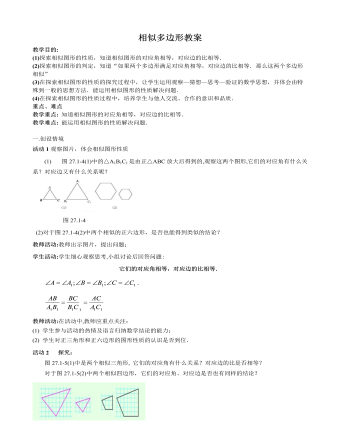
北师大初中数学九年级上册相似多边形2教案
(2)相似多边形的对应边的比称为相似比;(3)当相似比为1时,两个多边形全等.二、运用相似多边形的性质.活动3 例:如图27.1-6,四边形ABCD和EFGH相似,求角 的大小和EH的长度 .27.1-6教师活动:教师出示例题,提出问题;学生活动:学生通过例题运用相似多边形的性质,正确解答出角 的大小和EH的长度 .(2人板演)活动41.在比例尺为1﹕10 000 000的地图上,量得甲、乙两地的距离是30 cm,求两地的实际距离.2.如图所示的两个直角三角形相似吗?为什么?3.如图所示的两个五边形相似,求未知边 、 、 、 的长度.教师活动:在活动中,教师应重点关注:(1)学生参与活动的热情及语言归纳数学结论的能力;(2)学生对于相似多边形的性质的掌握情况.三、回顾与反思.(1)谈谈本节课你有哪些收获.(2)布置课外作业:教材P88页习题4.4
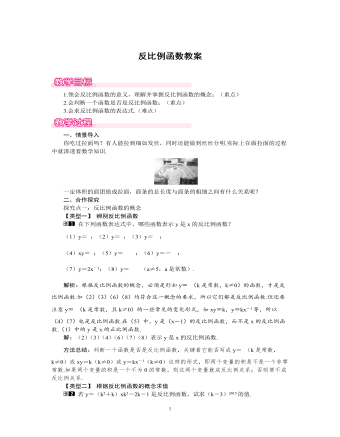
北师大初中数学九年级上册反比例函数1教案
解:(1)根据题意,可得y=100025x,化简得y=40x;(2)根据题设可知自变量x的取值范围为0<x<85.方法总结:反比例函数的自变量取值范围是全体非零实数,但在解决实际问题的过程中,自变量的取值范围要根据实际情况来确定.解题过程中应该注意对题意的正确理解.三、板书设计反比例函数概念:一般地,如果两个变量x,y之间 的对应关系可以表示成y=kx(k 为常数,k≠0)的形式,那么称y 是x的反比例函数,反比例函数 的自变量x不能为0确定表达式:待定系数法建立反比例函数的模型结合实例引导学生了解所讨论的函数的表达形式,形成反比例函数概念的具体形象,从感性认识到理性认识的转化过程,发展学生的思维.利用多媒体创设大量生活情境,让学生体验数学来源于生活实际,并为生活实际服务,让学生感受数学有用,从而培养学生学习数学的兴趣.
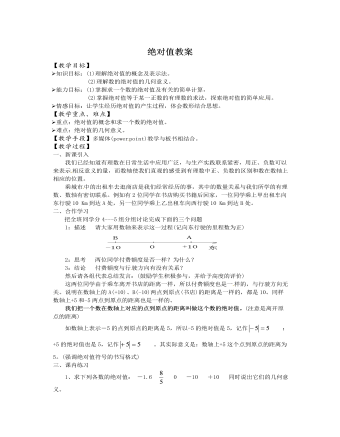
北师大初中七年级数学上册绝对值教案2
4、 填表:相反数 绝对值21 0 -0.75 5、 画一条数轴,在数轴上分别标出绝对值是6 , 1.2 , 0 的数6、 计算:(1) (2) 五、探究学习1、某人因工作需要租出租车从A站出发,先向南行驶6 Km至B处,后向北行驶10 Km至 C处,接着又向南行驶7 Km至D处,最后又向北行驶2 Km至E处。请通过列式计算回答下列两个问题:(1) 这个人乘车一共行驶了多少千米?(2) 这个人最后的目的地在离出发地的什么方向上,相隔多少千米 ?2、写出绝对值小于3的整数,并把它们记在数轴上。六、小结一头牛耕耘在一块田 地上,忙碌了一整天,表面上它在原地踏步,没有踏出这块土地,但我们说,它付出了艰辛和汗水,因为它所走过 的距离之和,有时候我们是无法 想象的。这就是今天所学的绝对值的意义所在。所以绝对值是不考虑方向意义时的一种数值表示。七、布置作业做作业本中相应的部分。
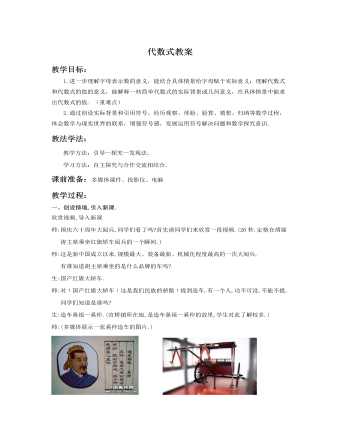
北师大初中七年级数学上册代数式教案2
1.进一步理解字母表示数的意义,能结合具体情景给字母赋于实际意义;理解代数式和代数式的值的意义,能解释一些简单代数式的实际背景或几何意义,在具体情景中能求出代数式的值. (重难点)2.通过创设实际背景和引用符号,经历观察、体验、验算、猜想、归纳等数学过程,体会数学与现实世界的联系,增强符号感,发展运用符号解决问题和数学探究意识. 教法学法:教学方法:引导—探究—发现法.学习方法:自主探究与合作交流相结合.课前准备:多媒体课件、投影仪、电脑教学过程:一、创设情境,引入新课.欣赏视频,导入新课师:国庆六十周年大阅兵,同学们看了吗?首先请同学们来欣赏一段视频.(26秒.定格在胡锦涛主席乘坐红旗轿车阅兵的一个瞬间.)师:这是新中国成立以来,规模最大、装备最新、机械化程度最高的一次大阅兵.
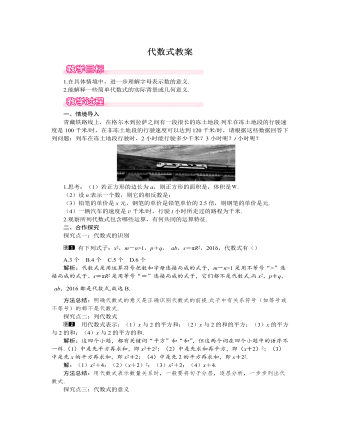
北师大初中七年级数学上册代数式教案1
方法总结:描述一个代数式的意义,可以从字母本身出发来描述字母之间的数量关系,也可以联系生活实际或几何背景赋予其中字母一定的实际意义加以描述.探究点四:根据实际问题列代数式用代数式表示下列各式:(1)王明同学买2本练习册花了n元,那么买m本练习册要花多少元?(2)正方体的棱长为a,那么它的表面积是多少?体积呢?解析:(1)根据买2本练习册花了n元,得出买1本练习册花n2元,再根据买了m本练习册,即可列出算式.(2)根据正方体的棱长为a和表面积公式、体积公式列出式子.解:(1)∵买2本练习册花了n元,∴买1本练习册花n2元,∴买m本练习册要花12mn元;(2)∵正方体的棱长为a,∴它的表面积是6a2;它的体积是a3.方法总结:此题考查了列代数式,用到的知识点包括正方体的表面积公式和体积公式,根据题意列出式子是解本题的关键.
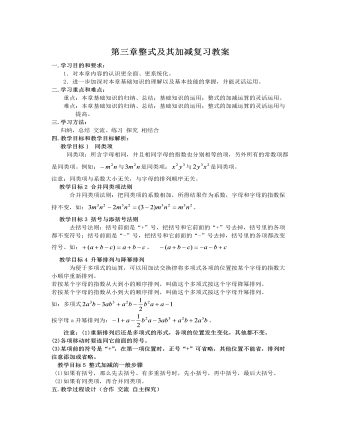
北师大初中七年级数学上册第三章复习教案
一.学习目的和要求:1.对本章内容的认识更全面、更系统化。2.进一步加深对本章基础知识的理解以及基本技能的掌握,并能灵活运用。二.学习重点和难点:重点:本章基础知识的归纳、总结;基础知识的运用;整式的加减运算的灵活运用。难点:本章基础知识的归纳、总结;基础知识的运用;整式的加减运算的灵活运用与提高。三.学习方法:归纳,总结 交流、练习 探究 相结合 四.教学目标和教学目标解析:教学目标1 同类项 同类项:所含字母相同,并且相同字母的指数也分别相等的项,另外所有的常数项都是同类项。例如: 与 是同类项; 与 是同类项。注意:同类项与系数大小无关,与字母的排列顺序无关。教学目标2 合并同类项法则 合并同类项法则:把同类项的系数相加,所得结果作为系数,字母和字母的指数保持不变,如: 。
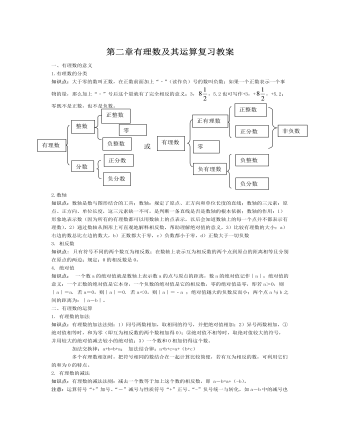
北师大初中七年级数学上册第二章复习教案
. 一个数的倒数等于它本身的数是()A.1 B. C.±1 D.04. 下列判断错误的是()A.任何数的绝对值一定是非负数; B.一个负数的绝对值一定是正数;C.一个正数的绝对值一定是正数; D.一个数不是正数就是负数;5. 有理数a、b、c在数轴上的位置如图所示则下列结论正确的是()A.a>b>0>c B.b>0>a>cC.b<a<0< D.a<b<c<06.两个有理数的和是正数,积是负数,则这两个有理数( )A.都是正数; B.都是负数; C.一正一负,且正数的绝对值较大; D.一正一负,且负数的绝对值较大。7.若│a│=8,│b│=5,且a + b>0,那么a-b的值是( )A.3或13 B.13或-13 C.3或-3 D.-3或-138. 大于-1999而小于2000的所有整数的和是()A.-1999 B.-1998 C.1999 D.20009. 当n为正整数时, 的值是()
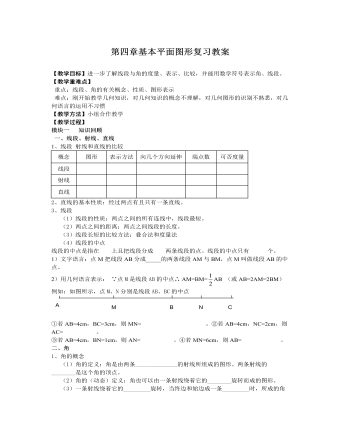
北师大初中七年级数学上册第四章复习教案
1、如图,OA、OB是两条射线,C是OA上一点,D、E是OB上两点,则图中共有 条钱段、它们分别是 ;图中共有 射线,它们分别是 。2、如果线段AB=5cm,BC=3cm,那么A、C两点间的距离是 3、(1)用度、分、秒表示48.26° (2)用度表示37°28′24″ 4、从3点到5点30分,时钟的时针转过了 度。5、一轮船航行到B处测得小岛A的方向为北偏西30°,则从A处观测此B处的方向为( ) A. 南偏东30° B. 东偏北30° C. 南偏东60° D. 东偏北60°6、已知,OA⊥OC,∠AOB∶∠AOC=2∶3,则∠BOC的度数为( )A. 30° B. 150° C. 30°或150° D. 不同于上述答案7、如图,AO⊥OB,直线CD过点O,且∠BOD=130°,求∠AOD的大小。8、已知:如图,B、C两点把线段AD分成2∶4∶3三部分,M是AD的中点,CD=6,求:线段MC的长。9、平面上有n个点(n≥2)且任意三个点不在同一直线上,经过每两个点画一条直线,一共可以画多少条直线?迁移:某足球比赛中有20个球队进行单循环比赛(每两队之间必须比赛一场),那么一共要进行多少场比赛?
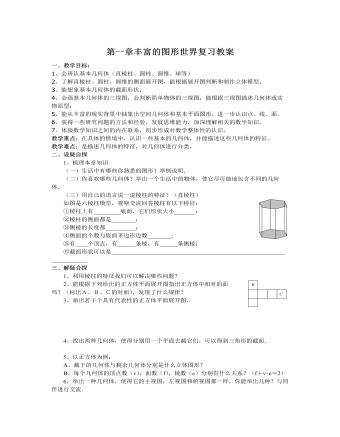
北师大初中七年级数学上册第一章复习教案
一、教学目标:1、会辨认基本几何体(直棱柱、圆柱、圆锥、球等)2、了解直棱柱、圆柱、圆锥的侧面展开图,能根据展开图判断和制作立体模型;3、能想象基本几何体的截面形状;4、会画基本几何体的三视图,会判断简单物体的三视图,能根据三视图描述几何体或实物原型;5、能从丰富的现实背景中抽象出空间几何体和基本平面图形,进一步认识点、线、面。6、获得一些研究问题的方法和经验,发展思维能力,加深理解相关的数学知识。7、体验数学知识之间的内在联系,初步形成对数学整体性的认识。教学重点:在具体的情境中,认识一些基本的几何体,并能描述这些几何体的特征。教学难点:是描述几何体的特征,对几何体进行分类。二、设疑自探1、梳理本章知识(一)生活中有哪些你熟悉的图形?举例说明.(二)你喜欢哪些几何体?举出一个生活中的物体,使它尽可能地包含不同的几何体.(三)用自己的语言说一说棱柱的特征?(直棱柱)
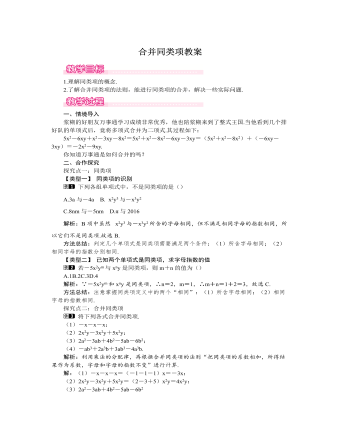
北师大初中七年级数学上册合并同类项教案1
一天,王村的小明奶奶提着一篮子土豆去换苹果,双方商定的结果是:1千克土豆换0.5千克苹果.当称完带篮子的土豆重量后,摊主对小明奶奶说:“别称篮子的重量了,称苹果时也带篮子称,这样既省事又互不吃亏.”你认为摊主的话有道理吗?请你用所学的有关数学知识加以判定.解析:要看摊主说得有没有道理,只要按称篮子和不称篮子两种方式分别求出所得苹果的重量,比较即可.解:设土豆重a千克,篮子重b千克,则应换苹果0.5a千克.若不称篮子,则实换苹果为0.5a+0.5b-b=(0.5a-0.5b)千克,很明显小明奶奶少得苹果0.5b千克.所以摊主说得没有道理,这样做小明奶奶吃亏了.方法总结:体现了数学在生活中的运用.解决问题的关键是读懂题意,找到所求的量之间的关系.三、板书设计数学教学要紧密联系学生的生活实际,本节课从实际问题入手,引出合并同类项的概念.通过独立思考、讨论交流等方式归纳出合并同类项的法则,通过例题教学、练习等方式巩固相关知识.教学中应激发学生主动参与学习的积极性,培养学生思维的灵活性.
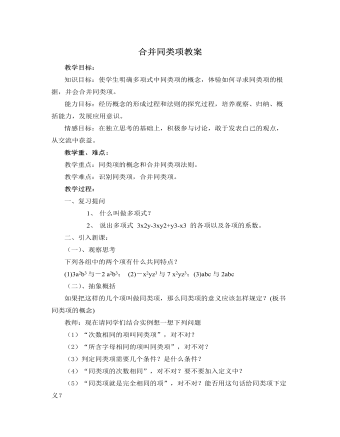
北师大初中七年级数学上册合并同类项教案2
本节课采取了开门见山的切入方法,旨在激发学生的求知欲望,在学生已有的认识基础上,让学生经历了“观察、思考、探究、实践”的过程。在总结出同类项定义后,没有按通常的做法,即直接分析定义中的两个条件,强调两个条件缺一不可,而是通过一组练习,让学生在具体问题中体会定义中的两个条件缺一不可,使他们先有较强烈的感性认识,而后,分析定义中的两个条件,这样会给学生留下更深刻、更牢固的印象.这样的设计既符合学生的年龄特征,也符合“从感性到理性、从具体到抽象”的认知规律。数学不应只强调抽象、严谨,这样不但会更显数学教学的枯燥,而且会使学生在学习中出现畏难情绪,甚至丧失学习数学的兴趣。通过本节课的教学,我认为还存在一些不足,一部分学生的学习能力还有待于进一步培养。如:学习同类项的概念时,当把字母顺序进行改变后,部分学生就认为不是同类项。
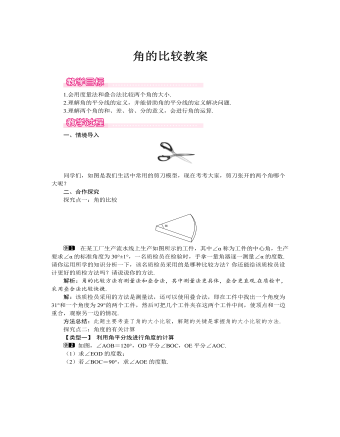
北师大初中七年级数学上册角的比较教案1
1.会用度量法和叠合法比较两个角的大小.2.理解角的平分线的定义,并能借助角的平分线的定义解决问题.3.理解两个角的和、差、倍、分的意义,会进行角的运算.一、情境导入同学们,如图是我们生活中常用的剪刀模型,现在考考大家,剪刀张开的两个角哪个大呢?二、合作探究探究点一:角的比较在某工厂生产流水线上生产如图所示的工件,其中∠α称为工件的中心角,生产要求∠α的标准角度为30°±1°,一名质检员在检验时,手拿一量角器逐一测量∠α的度数.请你运用所学的知识分析一下,该名质检员采用的是哪种比较方法?你还能给该质检员设计更好的质检方法吗?请说说你的方法.解析:角的比较方法有测量法和叠合法,其中测量法更具体,叠合更直观.在质检中,采用叠合法比较快捷.
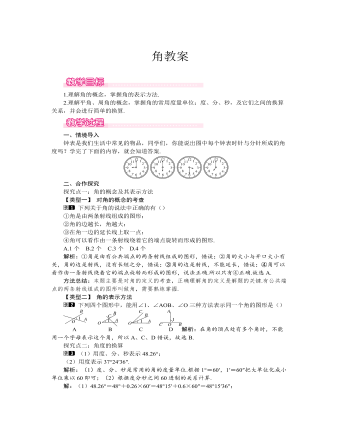
北师大初中七年级数学上册角教案1
1.理解角的概念,掌握角的表示方法.2.理解平角、周角的概念,掌握角的常用度量单位:度、分、秒,及它们之间的换算关系,并会进行简单的换算.一、情境导入钟表是我们生活中常见的物品,同学们,你能说出图中每个钟表时针与分针所成的角度吗?学完了下面的内容,就会知道答案.二、合作探究探究点一:角的概念及其表示方法【类型一】 对角的概念的考查下列关于角的说法中正确的有()①角是由两条射线组成的图形;②角的边越长,角越大;③在角一边的延长线上取一点;④角可以看作由一条射线绕着它的端点旋转而形成的图形.A.1个 B.2个 C.3个 D.4个解析:①角是由有公共端点的两条射线组成的图形,错误;②角的大小与开口大小有关,角的边是射线,没有长短之分,错误;③角的边是射线,不能延长,错误;④角可以看作由一条射线绕着它的端点旋转而形成的图形,说法正确.所以只有④正确.故选A.
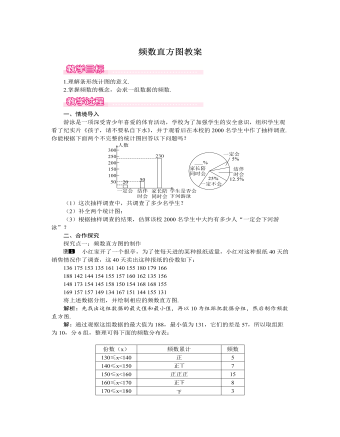
北师大初中七年级数学上册频数直方图教案1
一、情境导入游泳是一项深受青少年喜爱的体育活动,学校为了加强学生的安全意识,组织学生观看了纪实片《孩子,请不要私自下水》,并于观看后在本校的2000名学生中作了抽样调查.你能根据下面两个不完整的统计图回答以下问题吗?(1)这次抽样调查中,共调查了多少名学生?(2)补全两个统计图;(3)根据抽样调查的结果,估算该校2000名学生中大约有多少人“一定会下河游泳”?二、合作探究探究点一:频数直方图的制作小红家开了一个报亭,为了使每天进的某种报纸适量,小红对这种报纸40天的销售情况作了调查,这40天卖出这种报纸的份数如下:136 175 153 135 161 140 155 180 179 166188 142 144 154 155 157 160 162 135 156148 173 154 145 158 150 154 168 168 155169 157 157 149 134 167 151 144 155 131将上述数据分组,并绘制相应的频数直方图.解析:先找出这组数据的最大值和最小值,再以10为组距把数据分组,然后制作频数直方图.解:通过观察这组数据的最大值为188,最小值为131,它们的差是57,所以取组距为10,分6组,整理可得下面的频数分布表:
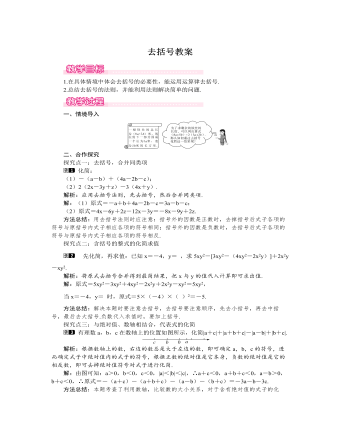
北师大初中七年级数学上册去括号教案1
方法总结:本题考查了利用数轴,比较数的大小关系,对于含有绝对值的式子的化简,要根据绝对值内的式子的正负,去掉绝对值符号.探究点四:含括号的整式的化简应用某商店有一种商品每件成本a元,原来按成本增加b元定出售价,售出40件后,由于库存积压,调整为按售价的80%出售,又销售了60件.(1)销售100件这种商品的总售价为多少元?(2)销售100件这种商品共盈利多少元?解析:(1)求出前40件的售价与后60件的售价即可确定出总售价;(2)由“利润=售价-成本”列出关系式即可得到结果.解:(1)根据题意得:40(a+b)+60(a+b)×80%=88a+88b(元),则销售100件这种商品的总售价为(88a+88b)元;(2)根据题意得:88a+88b-100a=-12a+88b(元),则销售100件这种商品共盈利(-12a+88b)元.方法总结:解决此类题目的关键是熟记去括号法则和熟练运用合并同类项的法则.
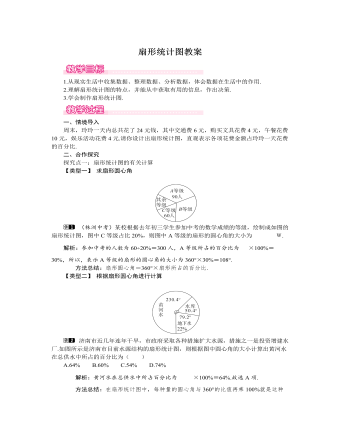
北师大初中七年级数学上册扇形统计图教案1
根据题意,得34%x-18%x=160,解得x=1000.所以48%x=48%×1000=480(公顷),18%x=18%×1000=180(公顷),34%x=34%×1000=340(公顷).答:玉米种了340公顷,高粱种了180公顷,水稻种了480公顷.方法总结:从扇形统计图中获取正确的信息是解题的关键.语文老师对班上学生的课外阅读情况做了调查,并请数学老师制作了如图所示的统计图.(1)哪种书籍最受欢迎?(2)哪两种书籍受欢迎程度差不多?(3)图中扇形分别表示什么?(4)图中的各个百分比如何得到?所有的百分比之和是多少?解:(1)科幻书籍最受欢迎,可从扇形的大小或图中百分比的大小得出.(2)科普书籍和武侠书籍受欢迎程度差不多,可从图中扇形大小或图中所标百分比的大小得出.(3)图中扇形分别代表了最喜欢某种书籍的人数占全班人数的百分比.(4)用最喜欢某种书籍的人数比全班的总人数即可得各个百分比,所有的百分比之和为1.方法总结:由扇形统计图获取信息时,一定要明确各个项目和它们所占圆面的百分比.

北师大初中七年级数学上册数据的收集教案2
1. 小明的脚长23.6厘米,鞋号应是 号。2.小亮的脚长25.1厘米,鞋号应是 号。3.小王选了25号鞋,那么他的脚长约是大于等于 厘米且小于 厘米。小结:刚才同学们都体会到了分组编码使原来繁多,无叙的数据简化、有序。因此分组、编码是整理数据的一种重要的方法,在工商业、科研等活动中有广泛的应用(四)反馈练习课内练习以下是某校七年级南,女生各10名右眼裸视的检测结果:0.2,0.5,0.7(女),1.0,0.3(女),1.2(女),1.5,1.2,1.5(女),0.4(女),1.5,1.1,1.2(女),0.8(女),1.5(女),0.6(女),1.0(女),0.8,1.5,1.2(1)这组数据是用什么方法获得的?(2)学生右眼视力跟性别有关吗?为了回答这个问题,你将怎样处理这组数据?你的结论是什么?(五). 归纳小结,体味数学快乐通过本节课的学习,你有那些收获?(课堂小结交给学生)数据收集的方法:直接观察、测量、调查、实验、查阅文献资料、使用互连网等。整理数据的方法:分类、排序、分组编码等。(学生可能还会指出鞋码和脚长之间的关系等)

北师大初中七年级数学上册数轴教案2
议一议数轴上的两个点,右边点表示的数与左边点表示的数有怎样的大小关系?数轴上表示的数,▁▁▁边的总比▁▁▁边的大;正数▁▁▁0,负数▁▁▁0,正数▁▁▁负数。练习:比较大小:-3▁5; 0 ▁-4 ;-3 ▁-2.5。3、合作交流(1) 什么是数轴?怎样画数轴。(2) 有理数与数轴上的点之间存在怎样的关系?(3) 什么是相反数?怎样求一个数的相反数?(4) 如何利用数轴比较有理数的大小?5、随堂练习:(1)下列说法正确的是( ) A、 数轴上的点只能表示有理数B、 一个数只能用数轴上的一个点表示C、 在1和3之间只有2D、 在数轴上离原点2个单位长度的点表示的数是2 (2)语句:①-5是相反数?②-5与+3互为相反数③-5是5的相反数④-5和5互为相反数⑤0的相反数是0⑥-0=0。上述说法中正确的是( )
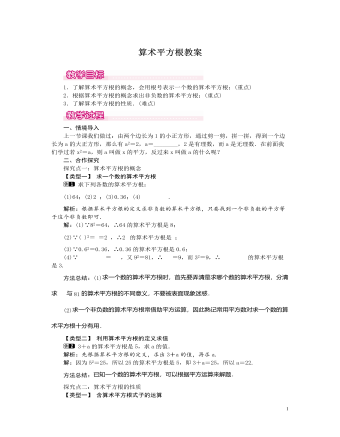
北师大初中数学八年级上册算术平方根教案
一、情境导入上一节课我们做过:由两个边长为1的小正方形,通过剪一剪,拼一拼,得到一个边长为a的大正方形,那么有a2=2,a=________,2是有理数,而a是无理数.在前面我们学过若x2=a,则a叫做x的平方,反过来x叫做a的什么呢?二、合作探究探究点一:算术平方根的概念【类型一】 求一个数的算术平方根求下列各数的算术平方根:(1)64;(2)214;(3)0.36;(4)412-402.解析:根据算术平方根的定义求非负数的算术平方根,只要找到一个非负数的平方等于这个非负数即可.解:(1)∵82=64,∴64的算术平方根是8;(2)∵(32)2=94=214,∴214的算术平方根是32;(3)∵0.62=0.36,∴0.36的算术平方根是0.6;(4)∵412-402=81,又92=81,∴81=9,而32=9,∴412-402的算术平方根是3.方法总结:(1)求一个数的算术平方根时,首先要弄清是求哪个数的算术平方根,分清求81与81的算术平方根的不同意义,不要被表面现象迷惑.(2)求一个非负数的算术平方根常借助平方运算,因此熟记常用平方数对求一个数的算术平方根十分有用.
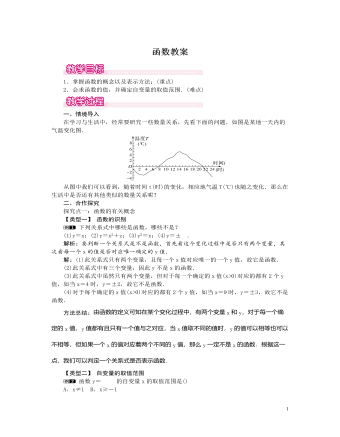
北师大初中数学八年级上册函数1教案
探究点三:函数的图象洗衣机在洗涤衣服时,每浆洗一遍都经历了注水、清洗、排水三个连续过程(工作前洗衣机内无水).在这三个过程中,洗衣机内的水量y(升)与浆洗一遍的时间x(分)之间函数关系的图象大致为()解析:∵洗衣机工作前洗衣机内无水,∴A,B两选项不正确,淘汰;又∵洗衣机最后排完水,∴D选项不正确,淘汰,所以选项C正确,故选C.方法总结:本题考查了对函数图象的理解能力,看函数图象要理解两个变量的变化情况.三、板书设计函数定义:自变量、因变量、常量函数的关系式三种表示方法函数值函数的图象在教学过程中,注意通过对以前学过的“变量之间的关系”的回顾与思考,力求提供生动有趣的问题情境,激发学生的学习兴趣,并通过层层深入的问题设计,引导学生进行观察、操作、交流、归纳等数学活动.在活动中归纳、概括出函数的概念,并通过师生交流、生生交流、辨析识别等加深学生对函数概念的理解.

